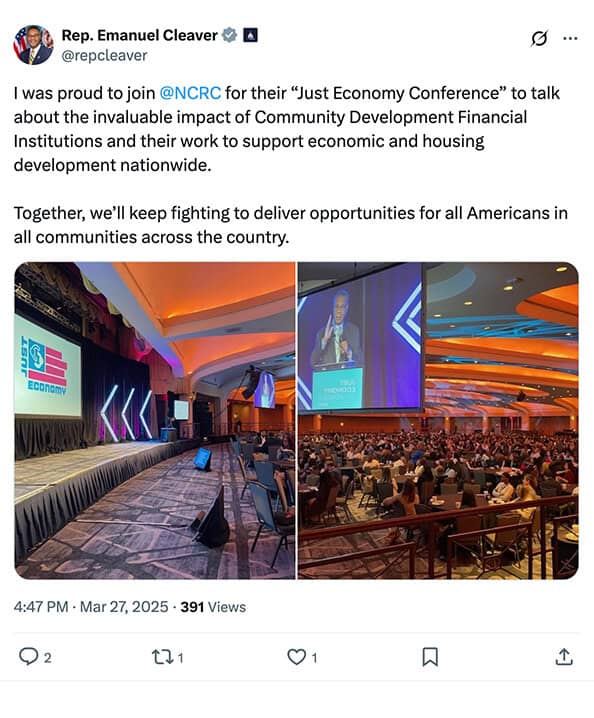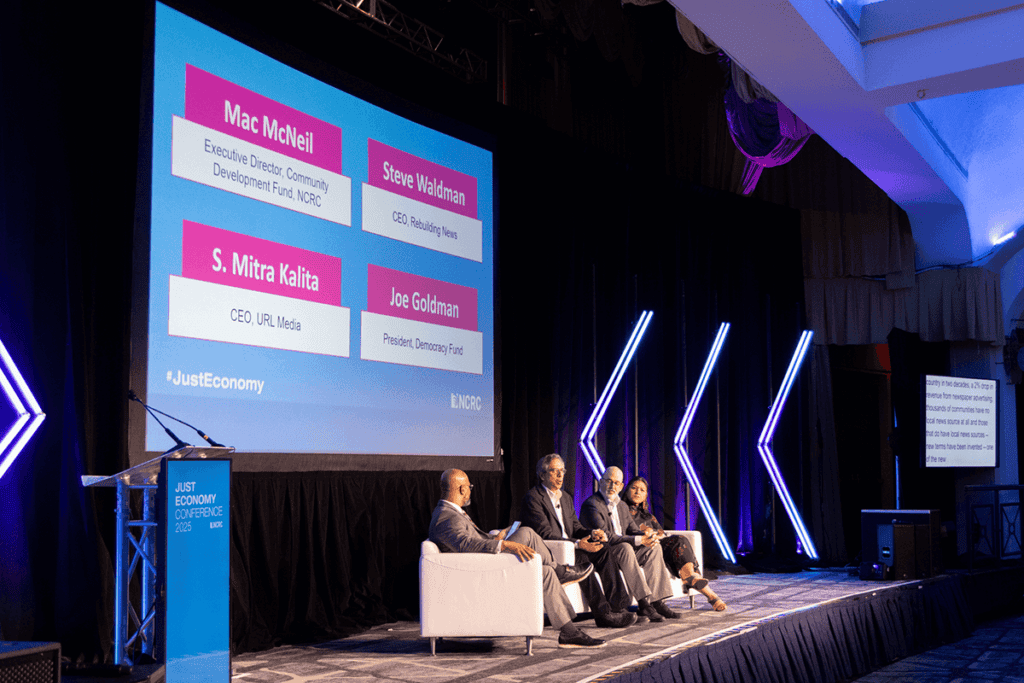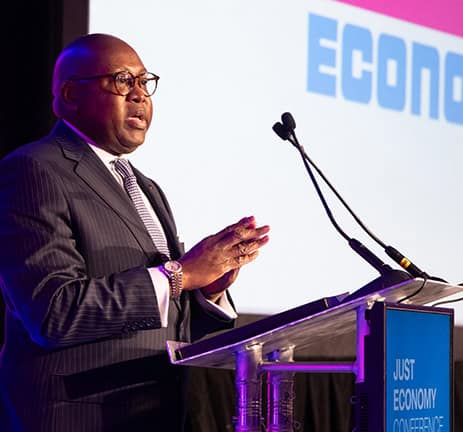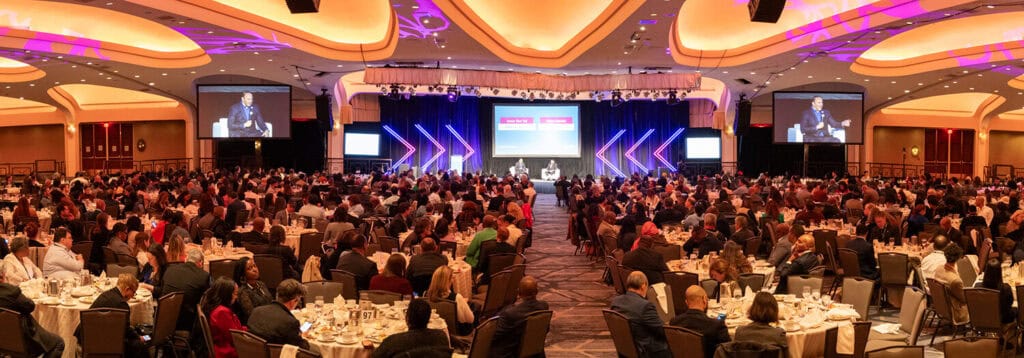Nearly 1,200 community development leaders, practitioners, policymakers, industry professionals and NCRC members from across the nation gathered at the 2025 Just Economy Conference March 26-27 in Washington, DC. They made new connections and shared knowledge on fair lending practices, climate resilience efforts, housing equity work and many other topics.
The conference main stage featured appearances from US Congresswoman Maxine Waters, Pulitzer Prize finalist scholar and writer Keeanga-Yamahtta Taylor, President and CEO of the National Urban League Marc Morial, US Congressman Emmanuel Cleaver, Acting Comptroller of the Currency Rodney Hood, New York State Department of Financial Services Superintendent Adrienne Harris, Illinois State Representative Sonya Harper, CEO of the Terence Crutcher Foundation Dr. Tiffany Crutcher, Equity and Transformation’s program director Alonzo Waheed, Huntington National Bank’s President of Consumer and Regional Banking Brant Standridge and the M&T Bank’s Senior Executive Vice President and Head of Community Banking Mike Keegan.
 Congressman Emmanuel Cleaver kicked off the mainstage programming with a riveting address on how we can continue building the Just Economy in the current national climate. Conference attendees then gained valuable insights on a variety of economic justice issues during our morning panel discussions and presentations, hearing from leaders in the fields of community land trusts, developing anchor collaboratives, home buying assistance programs on tribal land, inclusive social housing models and building CDFI talent pipelines.
Congressman Emmanuel Cleaver kicked off the mainstage programming with a riveting address on how we can continue building the Just Economy in the current national climate. Conference attendees then gained valuable insights on a variety of economic justice issues during our morning panel discussions and presentations, hearing from leaders in the fields of community land trusts, developing anchor collaboratives, home buying assistance programs on tribal land, inclusive social housing models and building CDFI talent pipelines.
At lunch in the ballroom of the Washington Hilton, NCRC President and CEO Jesse Van Tol gave a riveting address to our attendees about the power of the collective to fight back against seemingly insurmountable odds, and the need to lean into our movement’s power in confronting a hostile federal climate.
“[This] might be tough to hear, but sometimes this room full of lions acts more like a cage full of kittens [and] we’ve forgotten how to roar,” Van Tol said. “Not every person can run towards danger. Not every person can speak their dreams without fear of reprisal. But we can support each other to do hard things. Those of us who can, must. The life you save may even be your own.”
Throughout the week, non-member attendees heard about one key example of how NCRC helps our coalition flex its power. Our annual Hill Day prior to the conference saw hundreds of NCRC members visit with Members of Congress to advocate for a variety of economic and racial justice priorities. The members-only Hill Day culminated in an enlightening conversation with the founder and CEO of the Sanneh Foundation Tony Sanneh where he discussed the importance of community-based economic and youth development work.
Our conference attendees then learned about creative local work in afternoon breakout sessions covering innovative homeownership models for Black Coloradans, using redlining history to understand patterns of food insecurity, community wealth-building efforts and much more.
After a pair of evening receptions, including the annual members-only gathering where NCRC members got important inside updates on the work we are doing in 2025, attendees gathered again in the ballroom for a celebratory dinner emceed by NCRC Board Members Vernice Miller-Travis and Steve Glaude. The crowd heard about our latest Community Benefit Agreement and gave a standing ovation to outgoing Board Chair Bob Dickerson for his William Proxmire Lifetime Achievement Award, before dancing the night away to the Go-Go fusion stylings of DC’s own Rock Steady Project.
The second day of mainstage programming kicked off with powerful remarks from US congresswoman Maxine Waters on the risks facing us and how to preserve the important progress that economic and racial justice practitioners have made, with an inspiring call to action for continued advocacy on behalf of justice and equity. Following Waters’ remarks, conference attendees listened to an illuminating panel on the urgent need to reinvest in local news entities that can effectively cover the work NCRC members do, featuring Democracy Fund’s Joe Goldman, URL Media’ S. Mitra Kalita, and Rebuilding News’ Steve Waldman and NCRC CDF’s executive director Mac McNeil.
The second day’s morning panel discussions and presentations covered a wide variety of economic and racial justice topics, from financial wellness for job-seekers to public banking efforts to the chaos facing CDFIs around the country to the proper role of fintechs and AI systems in promoting fair lending rather than subverting it.

At lunch, Acting Comptroller of the Currency Rodney Hood told the ballroom crowd about some new initiatives to strengthen financial growth for underserved communities – specifically noting that without access to banks’ depository products, marginalized people and places can’t really begin to lift themselves up. National Urban League CEO Marc Morial then joined Jesse Van Tol for a moving fireside chat about the need to appreciate all of the progress we have made in this country thus far while having a realistic but constant resolve to fight uphill for the betterment of our communities.

After a last round of breakouts featuring such topics as climate resilience for vulnerable communities, trauma-informed community development and what the Trump Administration’s federal funding freeze will mean for nonprofits, the final mainstage session sought to expand the Just Economy movement’s understanding of what is possible back home.
Princeton University professor Keeanga-Yamahtta Taylor, Illinois state representative Sonya Harper, Equity and Transformation’s Alonzo Waheed, and the Terence Crutcher Foundation’s Dr. Tiffany Crutcher shared empowering thoughts about finding bold and innovative ways to fight for economic and racial justice through state and local reparations policies.
Then, after a spirited closing reception where attendees solidified new relationships and reignited old connections, it was time for everyone to head home and get back to work fighting for progress, dignity and opportunity for their neighbors.
Photos: Scott Henrichsen – www.scottFoto.com



